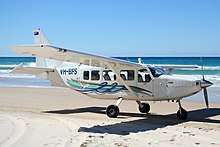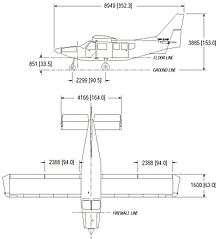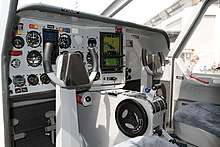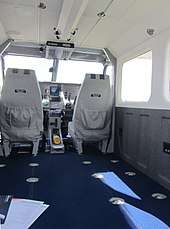GippsAero GA8 Airvan
The GippsAero GA8 Airvan 8 is a single-engined utility aircraft manufactured by GippsAero (formerly named Gippsland Aeronautics) of Victoria, Australia. It can seat up to eight people, including the pilot.
| GA8 Airvan | |
|---|---|
_Gippsland_Aeronautics_GA-8_Airvan_departing_Avalon_Airport_(1).jpg) | |
| Gippsland Aeronautics GA-8 Airvan 8 | |
| Role | Utility aircraft/Transport |
| National origin | Australia |
| Manufacturer | GippsAero |
| First flight | 3 March 1995 |
| Introduction | December 2000 |
| Primary user | United States Civil Air Patrol |
| Produced | 2000–present |
| Number built | ~240 delivered as of 2017[1] |
| Unit cost | |
| Variants | Gippsland GA10 |
The GA8 has been designed for use in remote areas and from austere air strips, performing tasks such as passenger services, freight, sightseeing, parachuting, observation, and intelligence, surveillance and reconnaissance (ISR) and search and rescue operations. Its design emphasises ruggedness and ease of use. First flown on 3 March 1995 and type certified under Federal Aviation Administration (FAA) Part 23 requirements during summer 2004, the GA8 has been flown by a diverse range of operators throughout the world.
Since its introduction, improved models featuring more powerful engines have been introduced; an enlarged turboprop-powered derivative, designated as the Gippsland GA10, has also been developed. A floatplane model of the GA8 has also been produced. At EAA Oshkosh 2014, the GA8 Airvan was officially renamed as Mahindra Airvan 8 as a reflection of GippsAero's recent acquisition by Indian conglomerate Mahindra Group. While produced in Australia to date, the establishment of a North American final assembly line to produce the type has been proposed.
Development


According to aviation publication Flying, the aircraft was designed to fill a market niche perceived by the manufacturer between the Cessna 206 and Cessna 208 Caravan models, with seating for six and up to fourteen passengers respectively.[3] The GA8's design was primarily produced by Peter Furlong. The aircraft was certified as conforming with the stringent Part 23 requirements of the Federal Aviation Administration (FAA); accordingly, elements were subject to dynamic testing, as well as the controllability of the aircraft with the loss of any primary flight control validated.[4] Having satisfied these requirements, the GH8 received its type certification during summer 2004.[3]
The GA8 has been used in various roles, including passenger services, freight, sightseeing, parachuting, observation, and search and rescue operations. It has been designed for use in remote areas and from austere air strips.[4]
A turbocharged version of the aircraft was in planning from 2004, and the prototype turbocharged aircraft commenced flight testing in October 2006. In February 2009, Gippsland Aeronautics announced that the Australian Civil Aviation Safety Authority had issued an amendment to the GA8 type certificate to cover the turbocharged variant. This version is designated as the GA8-TC320 and is powered by a 320 HP Lycoming TIO-540-AH1A Turbocharged Fuel Injected Engine. The first deliveries of this model took place in February 2009; within two years, numerous GA8-TC320 Airvans had been delivered to customers in Australia and New Zealand.[5]
A turboprop derivative of the GA8, the GA10, is also being developed. It is a slightly stretched 10-seat capacity aircraft powered by a Rolls-Royce 250-B17F/2 turboprop engine.[6] It is planned for the GA10 to retain as many common parts with the GA8 as possible.
During 2005, a floatplane model of the GA8 underwent evaluation.[7] In 2011, the company announced that it was preparing to put the float-equipped model of the GA8 into production in partnership with American aviation float manufacturer Wipaire.[8]
In December 2010, a Supplemental Type Certificate (STC) was issued to the manufacturer for a 200 lb. increase in MTOW.
In September 2012, the company was announced that Soloy Aviation Solutions had been appointed as a GA8 component distributor for the US market.[9] During November 2012, West Coast Aviation Services was appointed as an authorised dealer of the aircraft itself.[10] In January 2013, a second US company, Summit Aviation, became an authorised dealer of the GA8 in the US market; Sumit reportedly planned to focus on government and surveillance aircraft sales.[11]
At EAA Oshkosh 2014, the GA8 Airvan was officially renamed as Mahindra Airvan 8; this rebranding is a reflection of GippsAero's recent acquisition by Indian conglomerate Mahindra Group. At the event, a company spokesperson announced that plans were underway to establish a new assembly line to produce the aircraft in North America.[12][13] Mahindra has also undertaken substantial investments into its Australian facilities for the purpose of expanding its production capacity.[14][15]
Design
The GippsAero GA8 Airvan is an eight-seat utility aircraft specifically designed for routine operations within the hostile conditions of the Australian Outback.[3] In its original configuration, it was powered by a single Lycoming IO-540 piston engine; a derivative of the GA8, the GA10, is powered by a single Rolls-Royce 250-B17F/2 turboprop instead.[6] Its performance has been described as adequate, reportedly being capable of taking off within distances as short as 525 feet; under average conditions, the GA8 is expected to readily operate from a 1,000-foot air strip.[3] The handling has been described as forgiving, responsible, and akin to smaller aircraft.[4]
Externally, the aircraft bares a resemblance to the Cessna 208 Caravan, possessing a rectangular fuselage with large windows along its cabin.[3] Both passengers and crew are provided with a high level of visibility; in a standard seating configuration, each passenger is aligned with a sizable rectangular window which are bulged outwards to improve the downwards view. The use of a high-mounted wing located rearwards of the pilot's door improves the pilot's view range, particularly when looking upwards.[3][4] Unlike the majority of bush planes, the GA8's cabin can accommodate an aisle between the seats, improving passenger comfort; other comfort-enhancing features include evenly-distributed cabin ventilation and modular upholstery, the later being interchangeable to facilitate rapid replacement. Wherever possible, the aircraft has been designed to ease maintenance activities, minimising tooling required and maximising accessibility.[3] The cabin has a rear-facing door which can be opened mid-flight.[4]
Dedicated configurations are available for the skydiving, freight and intelligence, surveillance and reconnaissance (ISR) mission roles.[4] External payloads can also be carried within an optional cargo pod, which is capable of carrying up to 440 pounds; this pod can be accessed through both a side-door and rear-mounted hatch. When used an ISR platform, a modular pod containing multiple sensors, such as a Wescam-supplied surveillance/camera, can be installed; this pod may be furnished with a retraction mechanism so that the sensors can be concealed, making the pod appear as an ordinary cargo pod instead.[4] Various mission workstations can be installed in the cabin, which are designed to be secured upon the standard seat mounts, for ISR operators; in a standard ISR configuration, a crew of five - two pilots and three operators - is used.[4]
Both the airframe and onboard systems are designed to be durable and straightforward.[4] The undercarriage uses an oil-free spring-based suspension system, while the fuel system has its wing tanks, holding a combined 92.2 gallon, feeding into a single sump tank under the cabin floor without any fuel selector, removing the need for pilots to manage tank switching. The design of the wing is also simple, as are elements such as the mechanically-actuated flap.[4] Most components are designed for relatively lengthy service lives, such as the wings being rated for 92,000 hours; the lowest lifetime structural fitting is the aft vertical stabilizer fitting, needing replacement at 15,000 hours. Cockpit avionics incorporated includes the Garmin G500 multi-function display, Garmin GTN750 and 650 touchscreen satellite navigation units; the pilots are also provisioned with a complete suite of backup analog instruments.[4]
Variants
- GA8
- Production version with a Textron Lycoming IO-540-K1A5 engine.
- GA8-TC-320
- Variant with a Textron Lycoming TIO-540-AH1A engine.
Operators

.jpg)
228 Airvan 8s were in service as of July 2019.[16]
Civil
The GA8 is popular with air charter companies, skydiving operators and small feeder air carriers. Larger operators include the Civil Air Patrol which flies 18 Airvans for search and rescue operations. They are also used in CAP for long range disaster response and relief as well as airborne damage assessment missions. Mission Aviation Fellowship Australia operates eleven Airvans, providing air-transport services in developing countries.[17] Mission Aviation Fellowship Suriname operates two Airvans. Operators include the following:
- Air Fraser Island, Australia
- Glenorchy Air, New Zealand
- California Highway Patrol
Accidents and incidents
On 14 July 2019, a GA8 Airvan of Skydive Umeå crashed on Storsandskär, Sweden, killing all nine people on board.[19] Structural failure of a wing is suspected as a cause. The GA8 Airvan was grounded by the Civil Aviation Safety Authority (CASA) in Australia, Civil Aviation Authority in New Zealand, and the European Aviation Safety Agency (EASA) in the European Union.[20][21] The grounding order was issued on 20 July and was due to run until 3 August, but was lifted early as CASA found there is no evidence for an unsafe condition, and the EASA said the wrecked aircraft had been exposed to aerodynamic loads beyond certification.[22]
Specifications



Data from Jane's All The World's Aircraft 2003–2004[23]
General characteristics
- Crew: 1
- Capacity: Seven passengers
- Length: 8.95 m (29 ft 4 in)
- Wingspan: 12.28 m (40 ft 3 in)
- Height: 3.89 m (12 ft 9 in)
- Wing area: 19.32 m2 (208.0 sq ft)
- Aspect ratio: 7.9:1
- Empty weight: 997 kg (2,198 lb)
- Max takeoff weight: 1,814 kg (3,999 lb)
- Fuel capacity: 340 L (74.8 Imp Gallons)
- Powerplant: 1 × Textron Lycoming IO-540-K1A5 air-cooled flat-six, 220 kW (300 hp)
- Propellers: 2-bladed Hartzell F8475R constant speed propeller
Performance
- Maximum speed: 241 km/h (150 mph, 130 kn) at 1,525 m (5,000 ft)
- Cruise speed: 222 km/h (138 mph, 120 kn) at 3,050 m (10,000 ft)
- Stall speed: 97 km/h (60 mph, 52 kn) (flaps down)
- Range: 1,352 km (840 mi, 730 nmi)
- Endurance: Six hours
- Service ceiling: 6,100 m (20,000 ft)
- Rate of climb: 4.00 m/s (788 ft/min)
See also
Related development
- Gippsland GA10
Aircraft of comparable role, configuration and era
- Cessna 206
- Cessna 208
- Gavilán G358
References
Citations
- Kelly, Emma (1 March 2017). "Mahindra confident of imminent Airvan 10 certification". FlightGlobal. Reed Business Information. Retrieved 1 March 2017.
- "Purchase Planning Handbook" (PDF). Business & Commercial Aviation. Aviation Week Network. June 2019.
- Wallace, Lane (7 May 2005). "Caravan-Lite: Gippsland GA-8 Airvan". Flying Magazine. Archived from the original on 4 December 2008. Retrieved 15 February 2011.
- Thurber, Matt (1 March 2014). "Pilot Report: GippsAero Airvan Delivers Utility in a Fun To Fly Package". AIN Online.
- "GA web site". Gippsaero.com. Archived from the original on 16 February 2011. Retrieved 15 February 2011.
- "GA News Media Archives". Gipps Aero. 6 May 2005. Archived from the original on 16 February 2011.
- Kelly, Emma (5 January 2011). "Gippsland prepares to float turbocharged Airvan". Flight International.
- "GippsAero selects Soloy for GA8 Airvan support in USA". Flight International. 27 September 2012.
- Waldron, Greg (27 November 2012). "GippsAero appoints West Coast Aviation as GA8 Airvan distributor". Flight International.
- Waldron, Greg (24 January 2013). "GippsAero appoints Summit Aviation as GA8 dealer in USA". Flight International.
- "Mahindra floats US assembly for rebranded Airvan". FlightGlobal. 30 July 2014. Retrieved 4 August 2014.
- Sarsfield, Kate (16 August 2012). "GippsAero selects Soloy for GA8 final assembly in North America". Flight International.
- "Mahindra GippsAero GA8 TC 320 Airvan makes maiden landing in Mumbai". India Infoline News Service. 21 February 2011.
- Sarsfield, Kate (22 July 2010). "Mahindra invests in GippsAero subsidiary". Flight International.
- Cox, Lisa (21 July 2019). "More than 60 Australian-made planes grounded after fatal crash in Sweden". The Guardian. Retrieved 21 March 2019.
- "MAF web-page". Maf.org.au. 5 May 2010. Retrieved 15 February 2011.
- "GippsAero". GippsAero. 18 March 2004. Archived from the original on 16 February 2011. Retrieved 15 February 2011.
- Westin, Adam; Tronarp, Gustaf; Jamshidi, Jamshid; Toll, Michael; Laneby, Sebastien (14 July 2019). "Flygplan har kraschat utanför Umeå – nio personer döda" [Aircraft has crashed near Umeå - nine people dead]. Aftonbladet (in Swedish). Retrieved 19 July 2019.
- "CASA Australia and EASA ground GA-8 Airvan following a recent accident in Sweden". Aviation Safety Network. Retrieved 19 July 2019.
- "New Zealand authorities ground 21 planes after Sweden crash kills nine ". New Zealand Herald. 20 July 2019. Retrieved 20 July 2019.
- Sarsfield, Kate (29 July 2019). "Regulators lift Airvan 8 grounding". Flightglobal.
- Jackson 2003, p. 6.
Bibliography
- Jackson, Paul (2003). Jane's All The World's Aircraft 2003–2004. Coulsdon, UK: Jane's Information Group. ISBN 978-0-7106-2537-3.
External links
| Wikimedia Commons has media related to: |